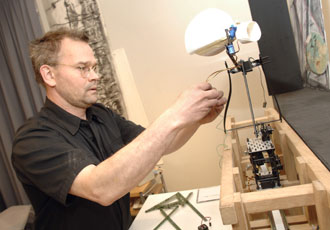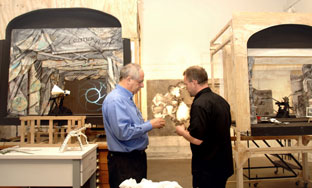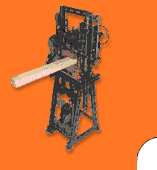|
|
|
Fac-system at
Moderna Museum
From February 3 until April 15, 2007, you were able to visit Moderna
Museet in Stockholm to see the project of William Kentridge, the Black Box.
The piece comprises a mechanized theatre, where the parts used mainly originated
from the Fac-system.
The project Black Box was made on behalf of Deutsche Guggenheim, but it
was produced in Sweden and in South Africa in cooperation with Mr. Jonas
Lundquist, prop maker, and Mr. Ronald Hallgren, programmer.
The show has also been presented in Johannesburg, in Salzburg and in Malmö
and it will be displayed in several other places in the near future.
Black box
The duration of the show is 23 minutes, comprises among other things our
Meccano covered with pasteboard and similar in order to create different
purposes and which is brought to and fro like a theater performance by means
of computers. The show itself begins with a megaphone, which like a presenter
announces a "Trauerarbeit" [an act of mourning]. The most important point
of departure of the work and which is alluded to in the act of mourning
is the forgotten massacre of the Herero people in the South-West Africa
by the Germans in the beginning of the 20th century. In 1885, South-West
Africa became a German protectorate, after which settlers began to encroach
upon and exploit the land of the African indigenous people. Out of frustration,
the Herero people revolted in 1904 against the colonisers who hit back against
the uprising with disproportionate force. This atrocity is often referred
to as the first genocide of the previous century.
However, the show is not a linear narrative but rather conveys itself through
our senses. It is at times beautiful, violent, horrible and sad. The show
has also been presented in Berlin in 2005.
William Kentridge
| |

Jonas Lundquist at work with the mechanism for the show, using
several FAC components. |
| |
|
William Kentridge is born in 1955 in Johannesburg, South Africa. He studied
political science and art in Johannesburg and Paris. He works with drawing
and short animated films, where he comments on South Africa's history and
apartheid.
Already in his first film, Kentridge began to develop what became a characteristic
element of his work: the animation of entire sequences from a single sheet
of paper. By having a fixed camera registering how he draws, erases, continues
to draw and gradually alters the image, he depicts the transformations and
movements that have come to define his work. The uninhibited flow of associations
arising from when something suddenly turns into something else is reminiscent
of the imagination of a child. However, the technique also carries a conceptual
meaning. Each new frame carries the traces of the previous frames as wounds
or memories from transformations and alterations, just as the present carries
with it traces of our history and we carry with us our experiences.

William Kentridge & Jonas Lundquist. |
 |
 |
|





